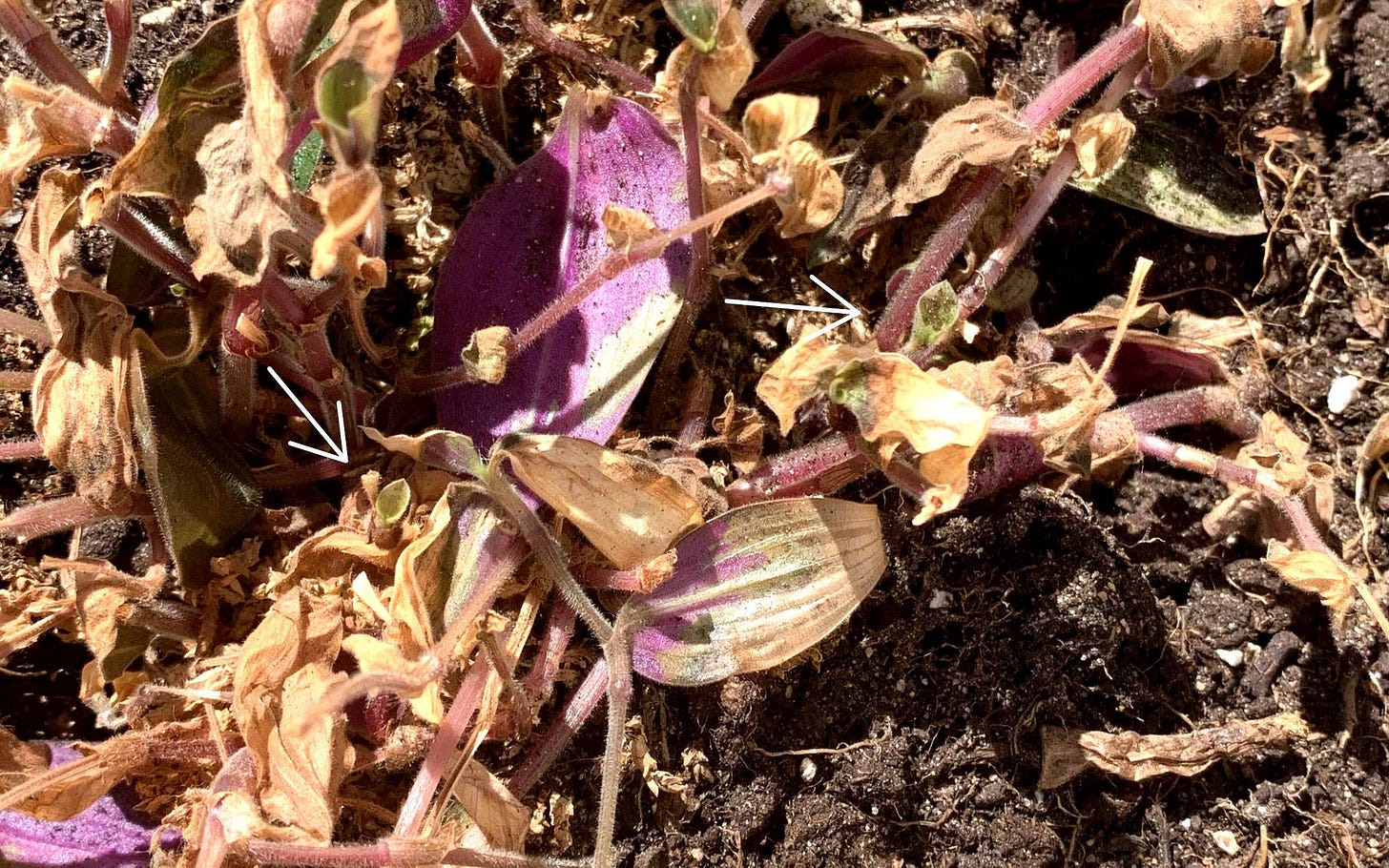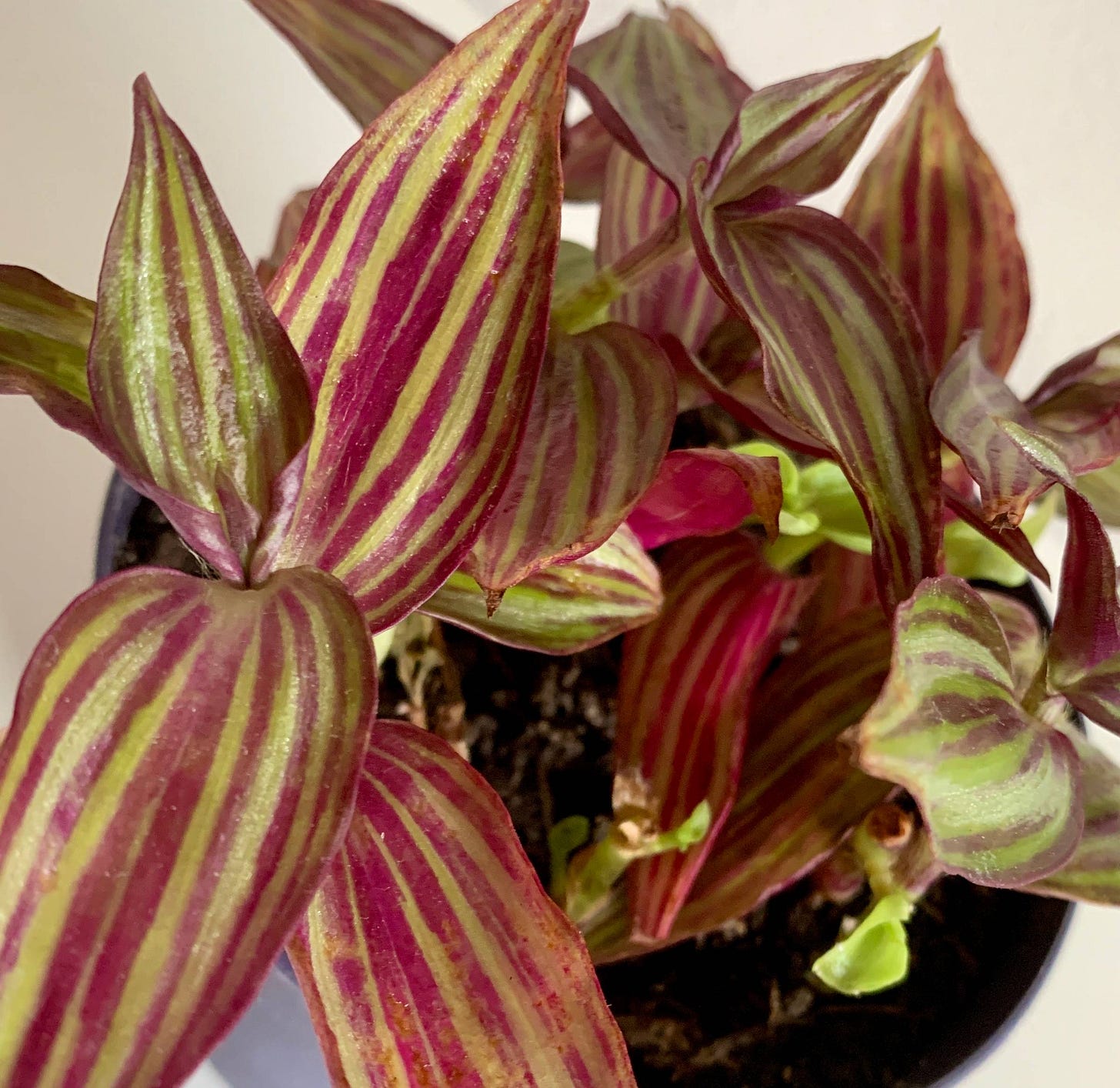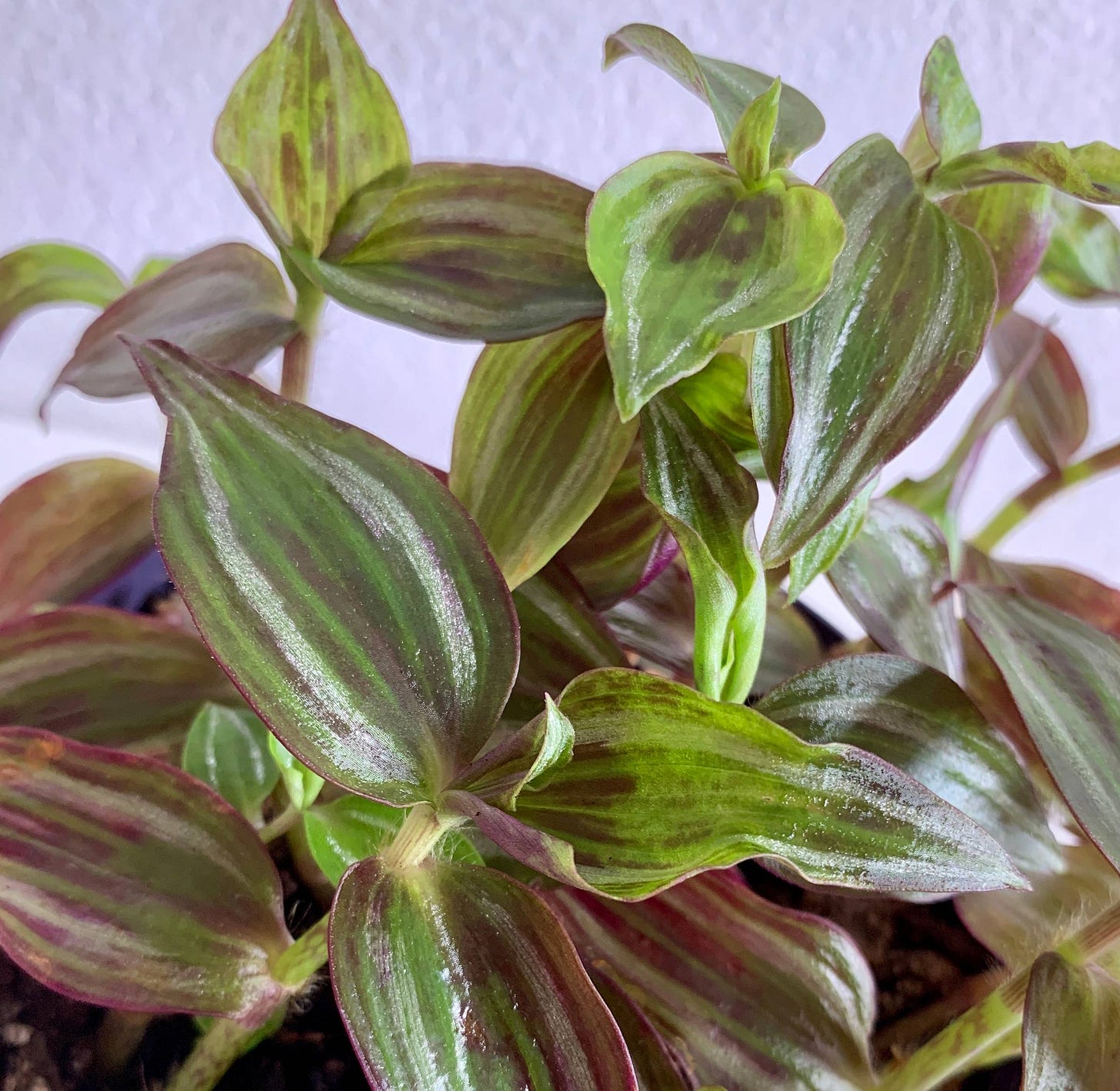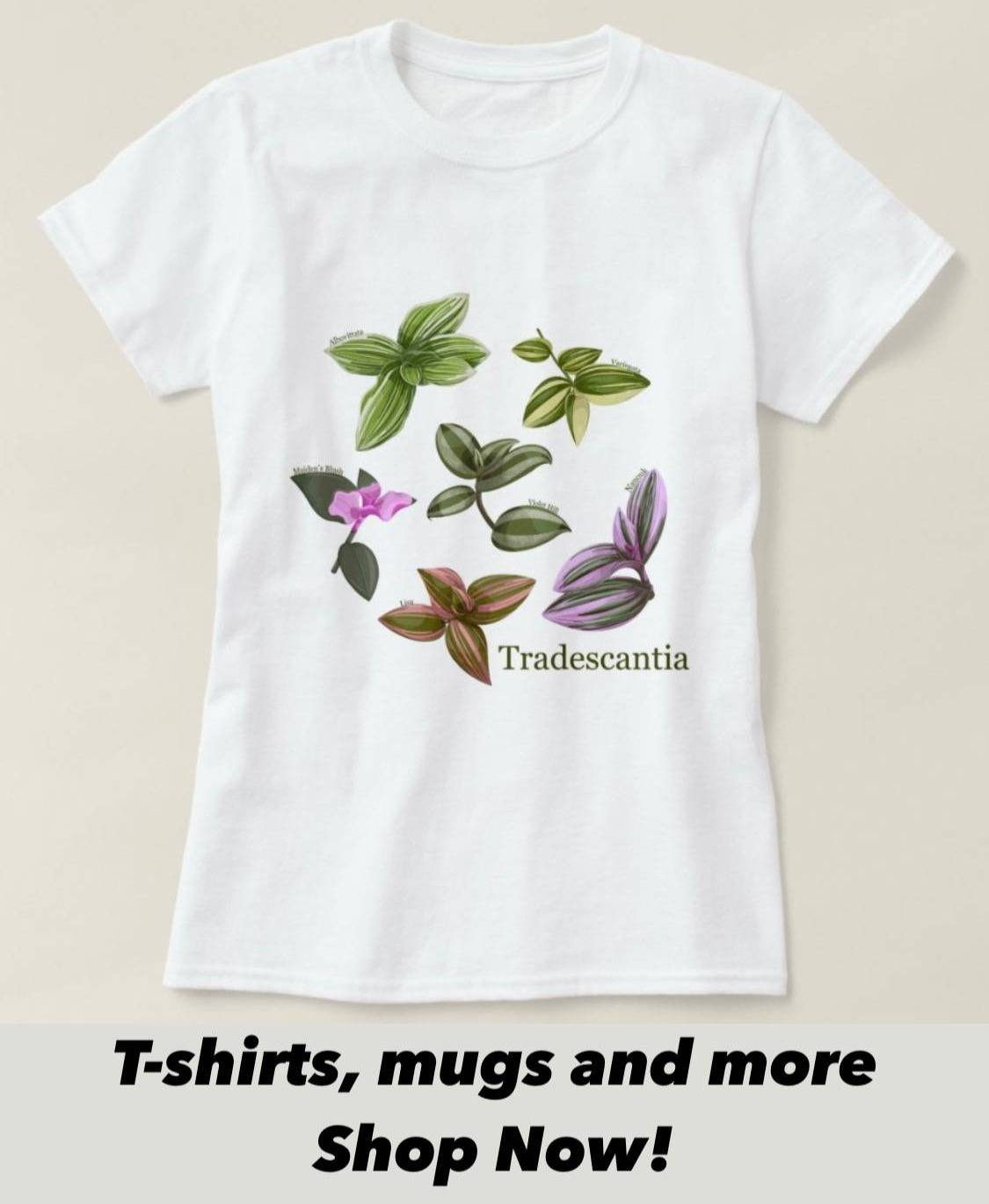Get Ready for Summer: Bringing your Tradescantias Outdoors
Finally, it’s May!
For me, that means I’ve started getting ready to move some of my Tradescantias outdoors.
Are you planning to have any of your Tradescantias outside this summer?
In this newsletter, I’ll walk you through everything you need to know to make sure your plants are happy in the summer sun.
Plus, don’t miss the Tradescantia of the Week—Zebrina Tikal. Is it really plagued by an incurable virus?
I’ll dive into that intriguing topic too.
Tradescantia of the week: Tradescantia Zebrina Tikal
Tradescantia of the Week: Zebrina Tikal
This week’s highlight is Zebrina Tikal, a variety collected from the wild in Guatemala in 2013, and named after the area in which it was found. Its most interesting features are the blood-red pinstripes that appears in bright light. It also has the typical Zebrina silver stripes and it blooms with light purple flowers.
However, Zebrina Tikal is not without its quirks. Many people have noticed that it seems to be prone to brown spots, leaf curling, and other signs of distress. This often lead to speculation about its health. When it first appeared, there were rumors that it had a virus or even bacterial infections. But no evidence has ever supported these claims. And there have never been any reports that it has spread to other plants. It just seems like this particular variety is just prone to these imperfections.
If you own a Zebrina Tikal, adjusting its environment can make a big difference. Some say that it gets worse in cold temperatures and that it prefers warmer temperatures. From my own experience, it seems to prefer moderate sunlight and benefits from higher humidity. It’s good to know that these issues are nothing serious and won’t spread to your other plants.
Bringing Your Tradescantias Outdoors for Summer
Summer is my favorite season. Not just because I’m not a fan of the cold, but also because I enjoy watching everything turn green and the flowers bloom. This is true for my Tradescantias as well. They look great indoors, but they show their best colours when they’re outside in the summer sun! So, as soon as there’s no more risk of frost, I begin the process of moving my Tradescantias outdoors.
However, while it’s exciting to bring your Tradescantias into the fresh air, there are a couple of important considerations to keep in mind. From getting them used to their new environment to understanding their needs for water, fertilizer, and sunlight, moving your plants outdoors takes a bit of planning and care. Let’s look at how you can safely move your Tradescantias outside, making they stay healthy and beautiful all season long.
Deciding Which Tradescantias to Move Outdoors
Before you start moving any plants outside for the summer, it’s important to think ahead to autumn. One of the biggest risks of bringing indoor plants back inside after summer is accidentally introducing pests into your home. This doesn’t have to be a problem if you have a plan in place. Consider setting up a quarantine area, using preventive treatments, or simply keeping a close eye on them to manage any potential pest issues.
Another strategy is to choose which plants you’re okay with leaving outside over the winter. That’s what I often do. I take cuttings and plant them outside, or when I’m restarting a plant indoors, I’ll plant out the old root ball. This way, I don’t have to worry about bringing hitchhikers back inside.
A third option, if you have the space, is to use a storage area or similar space where you can place them during the winter. This past winter, I kept some of my plants in a storage room next to a window. As long as the temperature doesn’t drop below freezing, they should be fine there.
The Right Temperatures for Moving Tradescantias Outdoors
Temperatures are important in determining when to move your Tradescantias outside. These plants are sensitive to cold, and it’s important to wait until the risk of frost has completely passed before transitioning them outdoors. In many regions, this generally means waiting until late spring or early summer, depending on your local climate.
The ideal temperature for Tradescantias outdoors is when nighttime temperatures consistently stay above 10°C (50°F). If temperatures drop below this, the plants can suffer from cold stress, which may cause damage or slow their growth significantly.
Before you decide to move your plants outside, keep an eye on the local weather forecast. A sudden cold snap can undo all your hard work of acclimatization. If you’re in a region where the weather can be unpredictable, consider using a frost blanket temporarily to protect your plants if unexpected cold weather strikes.
Acclimatizing Your Tradescantias to Outdoor Conditions
When you’re ready to move your Tradescantias outside, it’s important to help them get used to the new environment gradually. This will help your plants adjust without stress.
Start by placing your Tradescantias in a shaded, protected area outside for a few hours each day. Gradually increase their exposure to sunlight over the course of a week or two. This slow transition helps prevent shock from the sudden change in temperature, light, and air flow which they aren’t used to indoors.
Keep a close eye on your plants during this period. Watch for signs of stress, such as wilting or sunburnt leaves, and adjust their exposure accordingly. Remember, the goal is to slowly introduce them to more direct sunlight, until they are comfortable staying outside for the whole day.
Alternatively, if you’re like me and don’t have the patience for a gradual acclimatization, you can plant them directly outdoors. It’s important to understand that they will likely struggle at first, and may even wilt completely. However, over time, they will recover and the new growth will be stronger and adapted to the new environment. It’s important to note that this method works best for plants with a well-established root system; cuttings might find it more challenging.

Placement and Sunlight for Tradescantias Outdoors
Choosing the right spot for your Tradescantias outdoors is important for their growth and overall health, and the best location can vary depending on the specific variety. While most Tradescantias love a lot of sunlight, not all can handle too much direct sun without some negative effects.
The Pallidas, and Sillamontanas really like bright conditions and handle direct sunlight well. In contrast, most green types of Tradescantias are quite adaptable and can do well in both sunny and moderately shaded areas.
The variegated varieties are more sensitive to strong sunlight. Although they can adjust to bright conditions, too much direct sun may cause their leaves to burn, so areas that receive filtered sunlight through trees are ideal.
It’s usually more of a problem if Tradescantias are placed in very shaded areas. Conditions that are too dark and damp can lead to issues similar to overwatering seen with indoor plants, such as root rot and limp, yellowing leaves.
Watering Needs for Outdoor Tradescantias
The watering needs for your Tradescantias vary depending on where they are placed. For plants in smaller pots, it’s important to keep an eye on them and water them according to their needs. These pots can dry out quickly, especially in warm, sunny weather, but it’s also important to avoid overwatering. Allow the soil in these smaller pots to dry out mostly between waterings to prevent any issues with excess moisture.
In contrast, Tradescantias planted in larger pots or directly in the ground generally require very little watering. The larger volume of soil retains moisture longer and provides more stability in hydration. But during periods of warm weather with no rain, it’s important to check the soil and water the plants if necessary.
Regardless of the size of the pot, always make sure there are drainage holes.
Fertilizing Outdoor Tradescantias
How often you need to fertilize your Tradescantias really depends on where they’re growing. If you have your plants in small pots, it’s a good idea to fertilize them just like you would with your indoor plants. This means giving them a dose of half-strength fertilizer once a month. This helps to makes sure they get enough nutrients without overfeeding.
For Tradescantias in larger pots or planted directly in the ground, they generally don’t need as much fertilizer. However, it’s still beneficial to give them some nutrients every 6 to 8 weeks.
There are many different types of fertilizers available. Choose one that suits your needs and is easy use.
Managing Pests on Outdoor Tradescantias
One advantage of outdoor plants is that natural enemies often help keep pest populations under control. However, some pests might still cause trouble. It’s important to handle any pest problems carefully to avoid harming beneficial insects, including pollinators.
Aphids can be managed effectively by spraying the affected plants with a soap solution.
Thrips are generally less problematic outdoors than indoors because natural predators in the garden usually keep them in check.
Last year, I encountered slugs that were damaging my Andersonianas. I managed this by using slug pellets scattered on the ground around the plants.
In all cases, it’s important to choose pest control solutions that are effective against the specific pests you are dealing with but that do not harm the environment or pollinators.
Consider Local Regulations
In some places, Tradescantias are considered invasive species, which can disrupt local ecosystems by outcompeting native plants. It’s important to check local regulations before planting them directly in the ground. If they are deemed invasive, consider keeping your Tradescantias in containers or raised beds to prevent them from spreading uncontrollably.
Ready to Enjoy Your Outdoor Tradescantias?
I hope this guide helps you feel prepared to move your Tradescantias outdoors this summer.
If you have any questions along the way or need a bit more advice on caring for your Tradescantias, don’t hesitate to reach out.
Until next time, happy planting! 🌿
Katja
Disclaimer: This is an affiliate link, which means I earn a small commission if you make a purchase using my code, at no extra cost to you. Your support helps me keep sharing Tradescantia tips and content—thank you!






